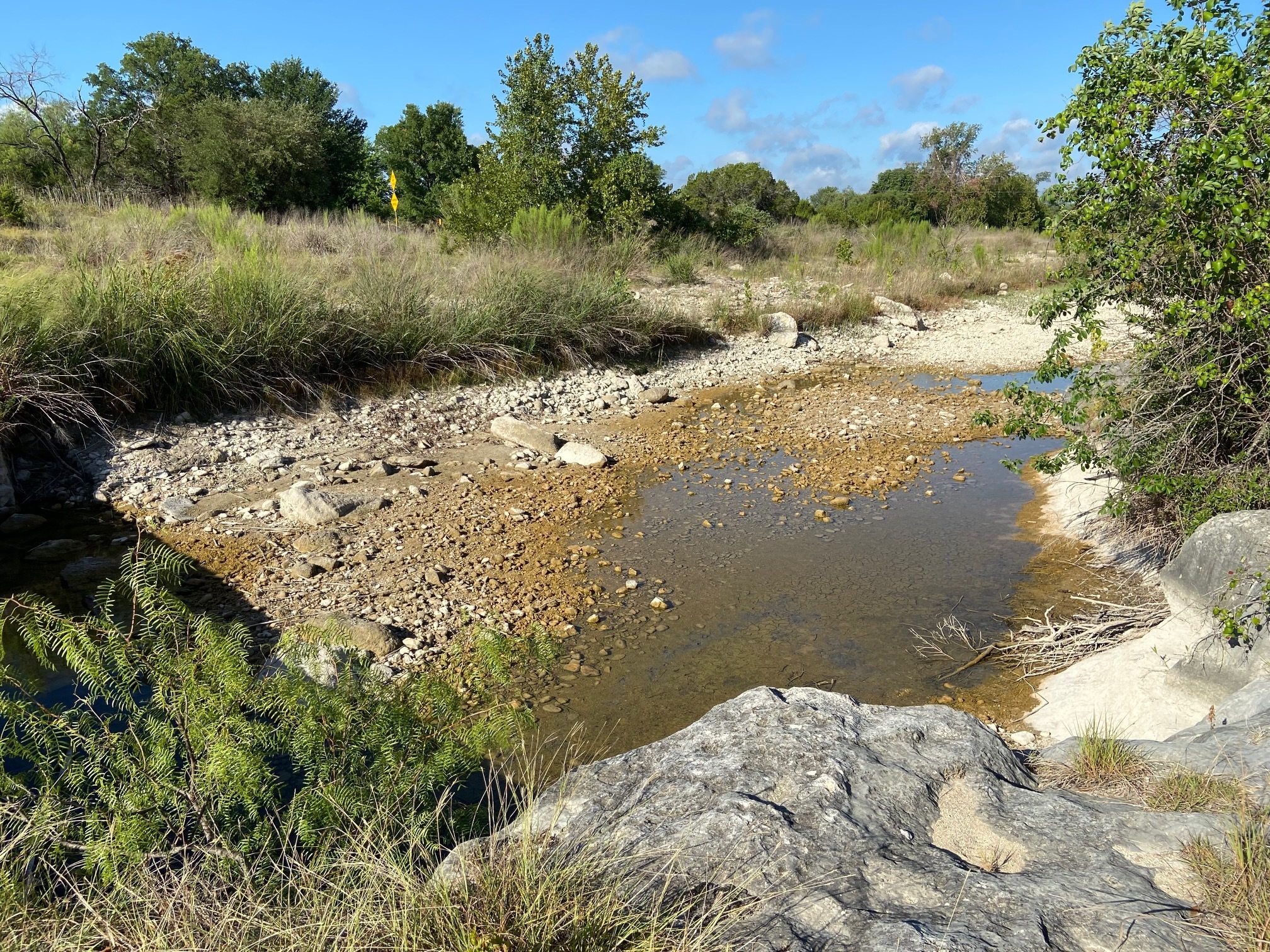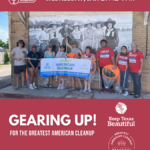Sean Johnston — Sabinal, Texas
About the Project
This storytelling project, led by Jazmin Storrs through her internship with Mobilize Green, offers a human perspective to the environmental challenges shaping life across Texas. From the Panhandle to South Texas, from coastal towns to Hill Country communities, interviews capture how people experience heat, drought, hurricanes, floods, and strong winds in their own backyards. Too often, these realities are contained in statistics, while the lived stories remain unheard. By centering personal voices, the project reminds us that whether facing storms, droughts, or flooding, we are bound by a common thread: our humanity. Each story calls us to listen with empathy, see beyond the data, and recognize that caring for the environment is inseparable from caring for one another.
20 Inches From the River’s Return
by Jazmin Storrs
In Sabinal, Sean Johnston is holding on to land, history, and hope for the water to come back.
About Sean Johnston
Sean Johnston is a rancher, writer, and community advocate from Sabinal, Texas. Raised on her family ranch, Sean shares her deep knowledge of local history and environmental changes through articles in Uvalco Magazine and the Uvalde Leader News. As a longtime volunteer and former secretary for Keep Sabinal Beautiful, she supports cleanups, community events, and grant writing, all driven by her passion for preserving Sabinal’s small-town character and strong community spirit.



Sean Johnston’s ranch in Sabinal, Texas

Sabinal, Texas – Photo by Larry Trulove
What have you observed in your environment?
In Sabinal, the drought is more than a shift in weather, it’s erasing a defining part of the town’s identity.
“The river brings a lot of people to Sabinal. And of course, the river is what Sabinal is named for. The Sabinal River, the Sabinal community, the cypress trees that grow on the Sabinal River, created the name.”

The Sabinal River lined with iconic cypress trees—a defining feature of the town’s natural beauty – Photo by Larry Trulove
Sean Johnston has witnessed environmental changes that were once unthinkable. The drought has lowered water levels and transformed the landscape entirely.
“We’ve had such a bad drought… the Sabinal river really is not flowing. It’s dry in many places. In my lifetime, I don’t ever remember that happening. Usually the Sabinal has three to six feet of water all the way and it usually has fresh fish. But that is no longer the case. We need about 20 more inches of rain for this drought to finish. The ground is just absorbing it.
The signs of water loss are not just in the rivers but in the land Sean grew up on. Springs and creeks that once defined her ranch are now long gone. “The creek that’s on my ranch used to have flowing water. It used to have spring water, and there’s no spring. The spring dried up by the time I was born. There was no spring in it. And so you see everything drying as the demand for water grows. With San Antonio growing west toward us, there’s more demand for water.”

Surrounding areas during severe drought with dry, cracked ground. – Photo by Ewan Bellamy – Flickr
And even when the rain finally comes, the damage doesn’t spare the land. Extreme weather is now marked by both scarcity and force.
“We had a storm about two weeks ago, really bad storm, and we got a lot of rain, which is great, but we also got a lot of wind and wind damage. All over Sabinal, there are uprooted trees on our ranch. There’s a huge 400-year-old oak that blew over and uprooted because the wind was so high, and we lost the crowns of two oak trees and a lot of mesquites.”

A damaged building in Sabinal, hit by straight-line winds of 60-80 mph during a recent storm on June 10-11th. the storm also uprooted trees across the area – Photo by Pete Luna, Uvalde Leader-News
How have these conditions affected your community?
The drying of the Sabinal has chipped away at the heart of the community—from tourism and safety to abandoned buildings and declining curb appeal.
“We don’t have a lot of people stop here. We have a lot of people go through here to get to Utopia. Rivers are generally better there… our river here is not pretty. The river is not deep and it’s not flowing enough in Sabinal anymore for it to be, ‘Oh, let’s go down to the Sabinal River and fish.’ Not enough water anymore. It’s all dried up, and yeah, it’s dried up closer to the headwaters.”
Severe weather, like storms and flooding, adds a layer of risk to an already stressed community—especially for those with older or neglected properties.
“Storms, floods, create a lot of damage, and you just have to make sure that your property is secured so that you don’t hurt anybody else. You aren’t liable for someone, you know, getting into an accident or something on Highway 90.”
“We finally got somebody to tear down an old building that was right at our line that looked really bad, and the lot still looks bad, but at least it doesn’t have that rickety building that was dangerous. I mean, if you were walking down the sidewalk, a piece of glass could fall out of that building. And there’s a couple of abandoned businesses and buildings that need to have something done to them—either demolished or fixed up.”

Responding to the Situation
In the face of storms and a changing environment, the community of Sabinal pulls together to restore what they can. Cleanup efforts have become a regular part of life, especially after severe weather.
“We do citywide cleanups, which means we’ll get maybe 20 people together, and we’ll get trailers with lawn mowers and weed whackers, and we’ll pick up garbage and take it to the trash. We’ll pick up brush piles—especially the last two weeks after the storm, volunteers got together and had trailers of old limbs and downed trees, and we’re putting it in the landfill.”
Much of this work relies on the tools and generosity of local ranchers and farmers, who not only bring equipment but also make up a key part of the volunteer base.
“Farmers and ranchers also have the big equipment. They’re going to have a drag behind a truck. They’re going to have, you know, a big, industrial-sized lawnmower. Or, you know, they’re going to have what it takes to do some of this stuff… they also make up a portion of your volunteering population as well.”
Why Care for the Environment?
For Sean Johnston, environmental care isn’t abstract, it’s a matter of survival for her community. With most residents working in agriculture, every drop of water matters.
“You can only put so many straws in the Edwards underground aquifer before it’s going to run dry. And that’s what you’re seeing out here. Since most of us are in agriculture—we’re raising cattle, we’re growing crops—we are really impacted by the lack of water.”
Her concern extends beyond day-to-day scarcity. She sees drought not as a passing problem, but as part of a long-term shift with lasting consequences.

Sean Johnston with local volunteers during a community cleanup effort in Sabinal, Texas
“Well, because they’re not making any more of it. It’s not a commodity that you can order more of. We have a finite amount of land and actually a finite amount of water. Water is becoming more and more scarce as global warming evaporates so much more of it. The heat is so much worse than it used to be. In the 50s, the drought was bad, but this recent drought in the last 20 years has been even worse. It’s dried up springs, it’s dried up huge rivers. It’s much worse than it used to be.”
Hopes for the Future
Sean Johnston believes the future begins with something simple but increasingly rare: rain. Her hope is grounded in both the environment and the spirit of her town.
“I hope for 20 more inches of rain. Frankly, that’s the big thing. And I also hope that we don’t lose our unique small-town feel… it’s nice to know everybody that you meet on the street. It really is. It’s very assuring, comforting.”

Sean Johnston’s okra and tomato plants flourishing after a 2007 flood in Sabinal

Jazmin Storrs
Jazmin Storrs is a student at the University of Texas at Austin, double majoring in International Relations and Humanities Honors, where she has designed a concentration titled Climate Policy, Human Rights, and the Media. As a Rapoport Community Service Scholar, Jazmin is recognized for her public service. She works as an Election Clerk to support voter access and recently traveled to Washington, D.C. to advocate for underserved communities.
As a Mobilize Green Intern, Jazmin supports Keep Texas Beautiful by leading storytelling on Texans’ environmental experiences. She is also the Climate Lead for UN Young Professionals and Vice Chair for Central Texas Model United Nations.
A violinist of over ten years, Jazmin earned 1st place at the 2022 New York National Orchestra Cup and performed at the International Midwest Clinic in 2023. Passionate about humanizing climate policy, Jazmin is dedicated to ensuring that everyday voices are represented in institutional spaces.


